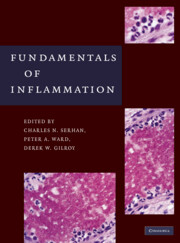Preface
Published online by Cambridge University Press: 05 April 2014
Summary
The acute inflammatory response is the body's first system of alarm signals that are directed toward containment and elimination of microbial invaders. Uncontrolled inflammation has emerged as a pathophysiologic basis to many of the widely occurring diseases in the general population that were not initially known to be linked to events in the inflammatory response. These include cardiovascular diseases and neurodegenerative diseases (including Alzheimer's disease), and it has now become apparent that inflammation is an important component of cancer progression and the persistence of neuropathic pain. These are diseases that cross many disciplines. To better manage treatment, diagnosis, and prevention of diseases, multidisciplinary research efforts are under way in both academic and industry settings. Since knowledge of the acute inflammatory response in itself spans many disciplines, the editors' mission is to provide in this text an introduction to the cell types, chemical mediators, and general mechanisms that are involved in this primordial first response of the host to invasion. It is also now clear that the termination or the resolution of the acute inflammatory response is an active process, which is pivotal and is the outcome of the acute response. As an endogenous programmed response, the terrain of resolution holds many new possibilities for treatment and prevention of uncontrolled inflammation in a wide range of diseases.
- Type
- Chapter
- Information
- Fundamentals of Inflammation , pp. xiii - xivPublisher: Cambridge University PressPrint publication year: 2010



